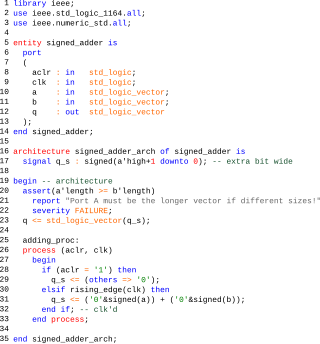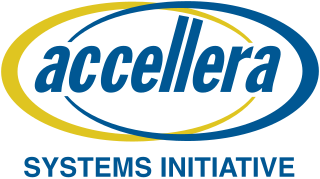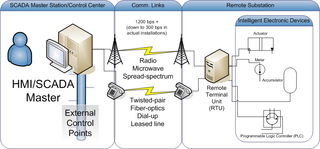
VHDL is a hardware description language that can model the behavior and structure of digital systems at multiple levels of abstraction, ranging from the system level down to that of logic gates, for design entry, documentation, and verification purposes. The language was developed for the US military VHSIC program in the 1980s, and has been standardized by the Institute of Electrical and Electronics Engineers (IEEE) as IEEE Std 1076; the latest version of which is IEEE Std 1076-2019. To model analog and mixed-signal systems, an IEEE-standardized HDL based on VHDL called VHDL-AMS has been developed.
Verilog, standardized as IEEE 1364, is a hardware description language (HDL) used to model electronic systems. It is most commonly used in the design and verification of digital circuits at the register-transfer level of abstraction. It is also used in the verification of analog circuits and mixed-signal circuits, as well as in the design of genetic circuits. In 2009, the Verilog standard was merged into the SystemVerilog standard, creating IEEE Standard 1800-2009. Since then, Verilog has been officially part of the SystemVerilog language. The current version is IEEE standard 1800-2023.
A PCI Mezzanine Card or PMC is a printed circuit board assembly manufactured to the IEEE P1386.1 standard. This standard combines the electrical characteristics of the PCI bus with the mechanical dimensions of the Common Mezzanine Card or CMC format.
Property Specification Language (PSL) is a temporal logic extending linear temporal logic with a range of operators for both ease of expression and enhancement of expressive power. PSL makes an extensive use of regular expressions and syntactic sugaring. It is widely used in the hardware design and verification industry, where formal verification tools and/or logic simulation tools are used to prove or refute that a given PSL formula holds on a given design.

Accellera Systems Initiative (Accellera) is a standards organization that supports a mix of user and vendor standards and open interfaces development in the area of electronic design automation (EDA) and integrated circuit (IC) design and manufacturing. It is less constrained than the Institute of Electrical and Electronics Engineers (IEEE) and is therefore the starting place for many standards. Once mature and adopted by the broader community, the standards are usually transferred to the IEEE.
A software requirements specification (SRS) is a description of a software system to be developed. It is modeled after the business requirements specification (CONOPS). The software requirements specification lays out functional and non-functional requirements, and it may include a set of use cases that describe user interactions that the software must provide to the user for perfect interaction.
SystemC is a set of C++ classes and macros which provide an event-driven simulation interface. These facilities enable a designer to simulate concurrent processes, each described using plain C++ syntax. SystemC processes can communicate in a simulated real-time environment, using signals of all the datatypes offered by C++, some additional ones offered by the SystemC library, as well as user defined. In certain respects, SystemC deliberately mimics the hardware description languages VHDL and Verilog, but is more aptly described as a system-level modeling language.
IEEE 802.1Q, often referred to as Dot1q, is the networking standard that supports virtual local area networking (VLANs) on an IEEE 802.3 Ethernet network. The standard defines a system of VLAN tagging for Ethernet frames and the accompanying procedures to be used by bridges and switches in handling such frames. The standard also contains provisions for a quality-of-service prioritization scheme commonly known as IEEE 802.1p and defines the Generic Attribute Registration Protocol.
A test plan is a document detailing the objectives, resources, and processes for a specific test session for a software or hardware product. The plan typically contains a detailed understanding of the eventual workflow.
IEEE P1363 is an Institute of Electrical and Electronics Engineers (IEEE) standardization project for public-key cryptography. It includes specifications for:
Software quality assurance (SQA) is a means and practice of monitoring all software engineering processes, methods, and work products to ensure compliance against defined standards. It may include ensuring conformance to standards or models, such as ISO/IEC 9126, SPICE or CMMI.
The Precision Time Protocol (PTP) is a protocol used to synchronize clocks throughout a computer network. On a local area network, it achieves clock accuracy in the sub-microsecond range, making it suitable for measurement and control systems. PTP is employed to synchronize financial transactions, mobile phone tower transmissions, sub-sea acoustic arrays, and networks that require precise timing but lack access to satellite navigation signals.
Standard Parasitic Exchange Format (SPEF) is an IEEE standard for representing parasitic data of wires in a chip in ASCII format. Non-ideal wires have parasitic resistance and capacitance that are captured by SPEF. These wires also have inductance that is not included in SPEF. SPEF is used for delay calculation and ensuring signal integrity of a chip which eventually determines its speed of operation.

Distributed Network Protocol 3 (DNP3) is a set of communications protocols used between components in process automation systems. Its main use is in utilities such as electric and water companies. Usage in other industries is not common. It was developed for communications between various types of data acquisition and control equipment. It plays a crucial role in SCADA systems, where it is used by SCADA Master Stations, Remote Terminal Units (RTUs), and Intelligent Electronic Devices (IEDs). It is primarily used for communications between a master station and RTUs or IEDs. ICCP, the Inter-Control Center Communications Protocol, is used for inter-master station communications. Competing standards include the older Modbus protocol and the newer IEC 61850 protocol.
The ISO/IEC 15288Systems and software engineering — System life cycle processes is a technical standard in systems engineering which covers processes and lifecycle stages, developed by the International Organization for Standardization (ISO) and the International Electrotechnical Commission (IEC). Planning for the ISO/IEC 15288:2002(E) standard started in 1994 when the need for a common systems engineering process framework was recognized. The previously accepted standard MIL STD 499A (1974) was cancelled after a memo from the United States Secretary of Defense (SECDEF) prohibited the use of most U.S. Military Standards without a waiver. The first edition was issued on 1 November 2002. Stuart Arnold was the editor and Harold Lawson was the architect of the standard. In 2004 this standard was adopted by the Institute of Electrical and Electronics Engineers as IEEE 15288. ISO/IEC 15288 was updated in 2008, then again in 2015 and 2023.
ISO/IEC/IEEE 42010Systems and software engineering — Architecture description is an international standard for architecture descriptions of systems and software.
Unified Power Format (UPF) is the popular name of the Institute of Electrical and Electronics Engineers (IEEE) standard for specifying power intent in power optimization of electronic design automation. The IEEE 1801-2009 release of the standard was based on a donation from the Accellera organization. The current release is IEEE 1801-2018.
IP-XACT, also known as IEEE 1685, is an XML format that defines and describes individual, re-usable electronic circuit designs to facilitate their use in creating integrated circuits. IP-XACT was created by the SPIRIT Consortium as a standard to enable automated configuration and integration through tools and evolving into an IEEE standard.
Advanced Library Format (ALF), also known as IEEE 1603 or IEC 62265, is an IEEE and IEC standard that describes a data specification language for library elements used in ASIC design applications for integrated circuits. ALF can model behavior, timing, power and noise, hot electron, electromigration, antenna effects, physical abstraction and physical implementation rules of library elements.
Lawrence Pileggi is the Coraluppi Head and Tanoto Professor of Electrical and Computer Engineering at Carnegie Mellon University. He is a specialist in the automation of integrated circuits, and developing software tools for the optimization of power grids. Pileggi's research has been cited thousands of times in engineering papers.


